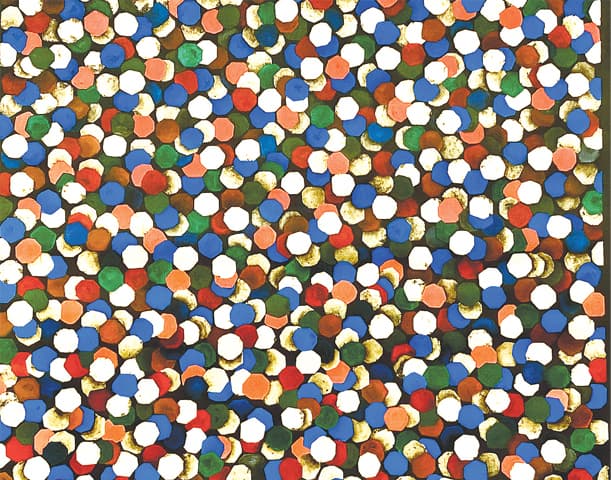
Looking at the intricate interlacing patterns of the Alhambra, Islamic manuscript borders or even the latticework on the tombs of Mughal mausoleums, is a transcendental experience. Representational images are replaced by triangles, octagons and hexagons, among other shapes. These become the basic units of complex geometric patterns that expand outwards like a carpet of stars, capturing the interconnectedness of nature so as to encapsulate the endless infinity of the cosmos. The colours of mosaics, frescoes and tiles shimmer as we move in and around the spaces that house and embody such fantastic representations of form and colour — we are left with a feeling that we have encountered something much bigger than ourselves, which engages with us on a basic human level.
The trajectory of Western art has, on the other hand, followed a different stream of consciousness till the advent of abstraction, when it began to engage in a steady dismantling and shedding of form and context as opposed to its previous interest in outward representation. Mark Rothko painted vast swathes of colour to evoke a feeling of the sublime; and Kandinsky spoke of “inner meaning” and the “spark” to explain the feeling of transcendence. Can some fragment of the complexity of such intimate human experiences, stripped off their context and history, still be captured in contemporary art today? Can such purity of light and colour be contained on a canvas? Does art even have to mean anything when stripped of representation?
Perhaps those are some of the questions that Nazia Ejaz recently asked through her artworks exhibited at Tanzara Gallery in Islamabad, titled It’s About Nothing II. The paintings, some in diptychs and triptychs, were mostly executed in oil on canvas and made extensive use of gold leaf and even sand. Broadly speaking, the vast oeuvre of work could be divided into two categories: the first consisting of immutable square and rectangular expanse of colour and texture, and the second consisted of compositions with overlapping shapes and lines. The use of the square and rectangle, shapes that seemed complete in themselves, appeared as containers for colour and form.
Nazia Ejaz’s paintings showcase the distillation of the complexity of traditions and cultural associations that make up our collective memory
Many of the titles such as ‘Stained Glass’ as suggested by its title did, in fact, evoke images of luminous rose windows and glimmering Islamic latticework screens, even as one gazed at a dramatic canvas of overlapping geometric hexagons and circles in hues of red, green, gold and ultramarine blue. Yet in many compositions the saturated hues also seemed reminiscent of the colours of the basic natural elements of nature such as the sky, water, sand and earth — as they sat next to each other they flickered, challenging our perception of their boundaries and the shapes blurred accordingly. Ejaz cites screens in the Indo/Islamic architectural tradition as a consistent motif that has inspired her works, while for her the use of the grid “operates as a screen that filters, constricts and constrains.”
Certain works eschewed this direct link of the grid or the screen or even of light though and charted new territory — such as in her series In Search Of A City, where the composition of a square within a square became more than just an exercise in exploring the tactile rawness of luminous gold texture and sand on a surface. Instead, it resembled an aerial view of a map of ruins. Devoid of context one could even argue that the works delved into far deeper meaning, for what the viewer was confronted with was not just a pattern of square depressions but the remnants of time and history.

Ejaz’s body of work is redolent of a solemn and introspective reflection of the vagaries of history. The title was ironic, for It’s About Nothing II can be interpreted as a distillation of the complexity of cultures, associations and traditions that make up our collective memory, stripped down to colour and form. To convey all that is no mean feat.
“It’s About Nothing II” was held at the Tanzara Gallery in Islamabad from September 10 to October 10, 2018
Published in Dawn, EOS, November 18th, 2018














































Dear visitor, the comments section is undergoing an overhaul and will return soon.